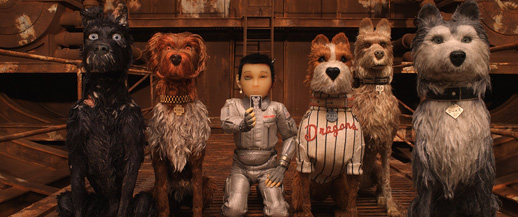Movie Review: Isle of Dogs
By Matthew Huntley
April 2, 2018
BoxOfficeProphets.com

In addition to its format and style, perhaps another reason “Isle of Dogs” is so reposing is because there's nothing terribly complicated its story. When I first saw the trailer, I didn't know what to make of it. Is it meant to be a comedy, a drama, a family picture, a social commentary, all of the above? After seeing it, I'm still not sure to what genre it officially belongs, but after thinking about it for a while, I figured director Wes Anderson and his team probably weren't trying to make a bold political statement or argue a certain point of view with regard to the plot. Sure, the film has moderate ties to real-world news and history, but these ultimately only serve as a backdrop to a simple yet effective story about companionship and loyalty, and because I didn't think the filmmakers were pushing a more important agenda, I didn't go seeking one. I simply let the film relax me. It may not be intellectually stimulating, but you'll nonetheless leave the theater feeling joyful and content.
The setup is rather straightforward: Twenty years into the future, Mayor Kobayashi (voice of Kunichi Nomura) of the fictional Japanese city of Megasaki, bans all dogs to Trash Island, citing the unwanted spread of an outbreak known as “dog flu.” Despite what he tells the press, Kobayashi's motivations for such a decree extend beyond his fear the virus will soon “enter the human disease pool.” His bias against dogs actually dates back to feudal Japan, “before the age of obedience,” when the cat-loving Kobayashi dynasty fought battles to prevent dogs from continuing to roam free around the earth.
Now, amidst the recent epidemic, he has an excuse to deport dogs completely, starting with his nephew Atari's faithful companion and bodyguard, Spots (Liev Schreiber). On the rubbish-filled colony, Spots and his canine brethren are forced to survive on garbage as the flu and “snout fever” trigger symptoms such as moodiness, narcolepsy, acute sneezing, color changes and fur loss. When Kobayashi refuses to listen to Professor Watanabe (Akiro Ito), who insists a cure is imminent, 12-year-old Atari (Koyu Rankin) steals a plane and flies to Trash Island in hopes of finding his best friend.
After crashing landing, he meets the story's main pack of characters, a group of mostly mellow yet burned out alpha dogs who decide to take Atari under their wing and help him on his mission, not least because it would remind them of what life used to be like and the important role dogs used to play in humans' lives. The diverse group includes the irascible and scarred Chief (Bryan Cranston); the master-longing Rex (Edward Norton); King (Bob Balaban); Boss (Billy Murray); and Duke (Jeff Goldblum). Because of his rough history, Chief is hesitant to befriend any human but is encouraged to show his gentler side by Nutmeg (Scarlett Johansson), a purebred show dog who's every bit as graceful and limber and she is classy.
Other members of the all-star cast include Tilda Swinton as an owl-eyed pug and Harvey Keitel as a supposedly cannibalistic half-breed, along with Greta Gerwig, Yoko Ono and Frances McDormand as some of the film's other human characters. McDormand particularly stands out as an English interpreter who delivers the play-by-play of Megasaki's mayoral election, the outcome of which could seal the fate of all dogs going forward.
Anderson's screenplay, from a story by Anderson, Roman Coppola, Jason Schwartzman and Kunichi Nomura, uses its light setup and colorful characters mostly to express affection and compassion toward any creatures (including humans) who may be shunned for reasons outside their control, as well as to highlight the importance of pets, family and loyalty, and to showcase beauteous imagery. And even though it's obvious they're present, it merely plays with the ideas of authoritarianism, dictatorship, prejudice, segregation, government corruption and moral rectitude; it doesn't exactly analyze them. If Anderson ever wanted to make a more politically charged film, I'm confident a storyteller of his caliber and style would really dissect the given themes and examine their complexity, making the narrative that much more biting.
But with “Isle of Dogs,” I'm pretty sure he just wants to engage us with charming dogs, deadpan humor, and, above all, sharp, picturesque imagery. Tristan Oliver's cinematography, with its heavy hues such as red, yellow and orange, which fill the background of Trash Island, combined with Andy Gent's exquisite, meticulously crafted models and puppets (of which there were over 500) make the film almost tangible and it inundates us like a vivid dream. We lose ourselves so much in the pacifying frames that the story becomes secondary, and while I do think the film's hesitancy to take narrative risks and make bolder, more polemical statements about its political and social themes prevents it from reaching greater cinematic heights, it still wonderfully utilizes the basest qualities of the medium, namely visuals, to lull us and take us away. It's in our best interest to simply let it.